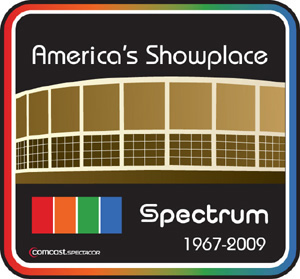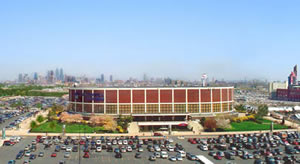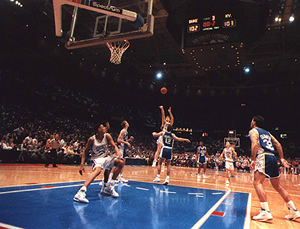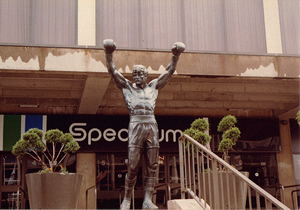
This was no ordinary hockey game—it was the Cold War on ice. “He had his head down. When he looked up to see where the puck was, I hit him. I hit him on the side of the head with my shoulder. It was perfectly legal. There was no reason why he should have stayed down. It was an ‘act’.” This was the contention of Philadelphia Flyers defenseman Ed Van Impe. His crushing hit on Soviet Red Army star Valeri Khalamov, in January of 1976 prompted the Soviet team to exit the ice in protest. The Soviets thought a penalty should have been called, but the referees did not agree. So Coach Konstantin Loktev signaled to his players to head to the locker room. This famous moment in Philadelphia sports history occurred in a building whose time was running short. Its name is the Spectrum. When describing this game, New York Times sports journalist Dave Anderson said the Flyers, “upheld the Spectrum’s reputation as the cradle of licensed muggings.”
The Spectrum sat at the intersection of Broad Street and Pattison Avenue in South Philadelphia. On his first visit, legendary sports columnist Red Smith characterized the new arena as an “elliptical hat box” and “a $12 million center of the perspiring arts.” While this stadium hosted a wide variety of events, it was the dream of a Philadelphia hockey team that made this building possible. “In the mid-sixties, we wanted to bring a hockey franchise to Philadelphia and had to build a new building to obtain one,” said Ed Snider, Chairman of Comcast-Spectacor, the group that owns the Flyers. Frank Fitzpatrick, sports writer for the Philadelphia Inquirer, also noted the importance of hockey to the Spectrum in a July 2008 article. “It was hockey, more than any sport, that lent the Spectrum its identity, particularly the Flyer’s Broad Street Bullies teams of mid-1970’s,” he said.
It took just sixteen months to complete construction of the Spectrum. The money needed to finance the building came from Jerry Wolman, the then owner of the Philadelphia Eagles. On September 30, 1967, the Quaker City Jazz Festival became the first event hosted by the Spectrum. On opening night, a spectator could buy hot dogs, beer, and soft pretzels for four people for about the same price as a gallon of gasoline today. The opening of the Spectrum was not glamorous. Samuel L. Singer wrote in the Philadelphia Inquirer, “As with nearly any new building, public or even a private home, everything wasn’t quite ready by the announced opening time of 8 P.M. The sound system was tested at 7 P.M. The parking directions apparently hadn’t been too well mapped out, however, and that plus a mammoth Schuylkill Expressway jamup helped delay the starting time till 8:55 P.M.” The Spectrum still received good reviews.

In the same article Singer says, “Those on the sides of the oval auditorium can see well. Those at the ends of the oval up in the balcony, are naturally farther but human figures are easily discernible. The sound is amplified from a host of loudspeakers suspended from the ceiling above the stage. Thus, the sound appears to come from the direction of the stage.”
The first ever sporting event held at the Spectrum was October 17, 1967. It was a heavyweight boxing match that showcased a young, up-and-coming “Smokin” Joe Frazier. It was truly a great moment for Philadelphians to acquire an indoor arena to house great sporting events for years to come.
But a fateful day occurred only months after opening the Spectrum. On February 17, 1968 at 1:45pm, a crowd of 11,000 filled the Spectrum to watch the Ice Capades. It was a windy day, with winds up to 49mph. A fierce wind managed to rip a hole in the Spectrum’s roof. Fortunately, no one in the arena was hurt, but three people suffered minor injuries when struck by flying debris in the parking lot outside. “It sounded like an airplane going over, then parts of the roof started falling in and the people started screaming,” said Marylyn Flecker, a Philadelphian in the audience. Philly sports fans would lose their home teams to other venues while the Spectrum underwent repairs.
More than anything, the Spectrum had character. When one looks around at the newer sports stadiums and arenas, they all have two things in common: 1) they are all named after a corporation, and 2) they are all equipped with luxury suites for society’s elite. There was a sort of intimacy in the Spectrum that can’t be gotten in the modern arena. There were times when the intimacy lost its charm, particularly when heading to the bathroom, where some of the more slovenly fans would rather relieve themselves in the sink than wait in line. Nonetheless, those who played there loved the Spectrum for better or for worse. It was a building that championed the “real” fans. “The Spectrum was different from arenas now,” said former 76ers great, Maurice Cheeks. “It’s packed in, smaller, tighter. There were none of those boxes, people were all up on you, and that’s what we got used to. You could familiarize yourself with the people. I remember one guy, Stevie, he sat right across from the bench. He still comes to the games at the Wachovia Center.”
The bicentennial celebration was a great year for the Spectrum. In 1976, it hosted both the National Basketball Association (NBA) and National Hockey League (NHL) All-Star Games, the only venue ever to host both in the same season. Philadelphia basketball fans could witness greats such as Kareem Abdul-Jabbar and Walt Frazier, as well as their home team stars, Doug Collins and George McGinnis. Philadelphia hockey fans were treated by seeing six Flyers all stars go against the legendary goaltender, Ken Dryden. The National Collegiate Athletic Association (NCAA) basketball Final Four was also hosted by the Spectrum in 1976. It was in the Spectrum that Bob Knight’s Indiana University Hoosiers completed their undefeated season by winning the NCAA championship, a feat that hasn’t been duplicated since.

The Spectrum provided the backdrop for some of the greatest moments in college basketball history. In addition to Indiana’s 1976 title, Knight’s Hoosiers would return to the Spectrum in 1981 to win their second NCAA title. If there is one game in college basketball history that reminds everyone why they watch sports, it is the 1992 NCAA national semifinal between the Duke Blue Devils and the Kentucky Wildcats. This game ended with an improbable buzzer-beating shot by Christian Laettner of Duke. “Here we’d been raging on the Spectrum,” says UPI’s Tom Withers, one of the 269 accredited journalists covering the game, “and then it gave us this gift.” The malfunctioning phone lines on press row could not ruin these journalists’ night.
As its name suggests, the Spectrum held a wide variety of events that was not limited to sports. Some of the legends in music have graced the Spectrum with their presence. Musical greats such as Elvis Presley, Frank Sinatra, Billy Joel, the Grateful Dead, the Rolling Stones and many more have performed inside the walls of the Spectrum. One of the more memorable concerts occurred on December 9, 1980 when Bruce Springsteen and the E. Street Band played their second night in a row there. The night before, music legend, John Lennon was murdered. Those who were there remember vividly what Bruce said upon entering the stage: “It’s a hard world that asks you live with a lot of things that are unlivable. And it’s hard to come out here and play tonight, but there’s nothing else to do.” The band finished the show with the song “Twist and Shout” as a final tribute to the giant of rock and roll.

On Halloween of 2009, Pearl Jam played the last concert ever to be held at the Spectrum. They gave the crowd a night to remember as they played a forty-one song, three and a half hour set with many rare performances. One of these rare performances was the song “Sweet Lew,” a tribute to Lew Alcindor, better known today as Kareem Abdul-Jabbar. Front man Eddie Vedder dribbled a basketball around the stage during the song, as Abdul-Jabbar once did in 1980 when the 76ers won their last NBA championship over the Los Angeles Lakers.
Unfortunately, all great things must come to an end. In October, 2009, the Spectrum came to an official close. “This has been one of the hardest decisions I’ve ever had to make,” Ed Snider said. “The Spectrum is my baby.” The house saw the likes of Philly sports greats like Dr. J, Moses Malone, Charles Barkley, Bobby Clarke, Bernie Parent, and the great Wilt Chamberlain. We live in a world where the motto is, “out with the old, in with the new,” an era where expansion is always taking place. That is precisely what is happening to the Spectrum. The area where the Spectrum used to sit will be the site of a project called Philly Live!, a retail, dining, and entertainment complex adjacent to the current sporting venues for all major sports teams in Philadelphia, helping satisfy Americans’ insatiable hunger for more malls.
Mr. Snider has an attachment to one of his first big projects, but it currently stands in the way of his next one. “Our vision when we built the Wachovia Center was to create the ultimate sports destination. Philly Live! Is the dining and retail entertainment component of that vision. Philly Live! will not be limited to sports and entertainment goers. This property will be open to everyone, everyday, whether they are attending an event or not.”
The City of Brotherly Love will surely miss the old girl—but, they’ll get over it. Bob Ford, columnist for the Philadelphia Inquirer put it best: “We move on. We change. We go to the new places. We walk past the parking lots where the old places used to be. We pause. We remember. And then we get a burger at the Hard Rock. What’s so bad?”
Sources:
- “1976 NBA All-Star Game Box Score.” Basketball-Reference.com. 1 Dec. 2009 <http://www.basketball-reference.com/allstar/NBA_1976.html>.
- “1976 NHL All-Star Game Rosters.” Hockey-Reference.com. 1 Dec. 2009. <http://www.hockey-reference.com/allstar/NHL_1976_roster.html>.
- Anderson, Dave. “Flyers Over Soviets: Capone-Like Ambush.” Ocala Star Banner 13 Jan. 1976: B4.
- DeLuca, Dan. “History lives one last night as Pearl Jam closes it out.” Philadelphia Inquirer 1 Nov. 2009: B1.
- DeLuca, Dan. “Spectrum showcased great music.” Philadelphia Inquirer 16 July 2008: A13.
- DiStefano, Joseph N. “Philly Live! details under development - Wachovia Spectrum would make way for a multi-use entertainment project. No word on casino prospects.” Philadelphia Inquirer 16 July 2008: A13.
- Fitzpatrick, Frank. “Wachovia Spectrum to be demolished.” Philadelphia Inquirer 16 July 2008: A1.
- Ford, Bob. “Memories won’t stand in way of progress.” Philadelphia Inquirer 16 July 2008: A12.
- “Hoosiers to add Knight to sports Hall.” ESPN. 22 Aug. 2009. 1 Dec. 2009. <http://sports.espn.go.com/ncb/news/story?id=4415861>.
- Meltzer, Bill. “Great Moments: Flyers Conquer the Red Army.” PHILADELPHIAFLYERS.COM. National Hockey League, 10 Jan. 2008. 11 Dec. 2009. <http://flyers.nhl.com/club/news.htm?id=435985>.
- Murray, George J., and Paul J. Levine. “11,000 Safe As Winds Rip Hole in Roof Of Spectrum.” Philadelphia Inquirer 18 Feb. 1968: 2. 1+.
- Singer, Samuel L. “Spectrum Opens With Quaker City Jazz Festival.” Philadelphia Inquirer 1 Oct. 1967: 29.
- Wolff, Alexander. “The Shot Heard Round The World.” Sports Illustrated 28 Dec. 1992. SIVault. 1 Dec. 2009. <http://sportsillustrated.cnn.com/vault/article/magazine/MAG1004691/2/ind....
